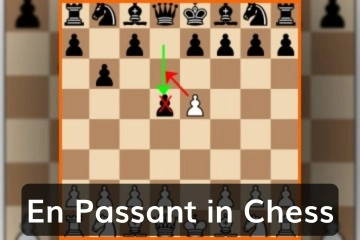Introduction
If you’ve ever seen a pawn disappear from the board without landing directly in front of the capturing piece, you’re not alone. You likely witnessed a rule many beginners don’t learn until much later: en passant.
Despite being a part of the official FIDE Laws of Chess, en passant is one of the most misunderstood rules in the game. It confuses beginners, surprises intermediate players, and even stuns spectators when seen in high-level tournaments.
In this article, we’ll break it down with clear explanations, simple diagrams, and real game examples so you’ll never be confused by en passant again.
What Is En Passant in Chess?
En passant, French for “in passing,” is a special pawn capture that only occurs under very specific conditions.
Here’s when you can use en passant:
- The opposing pawn moves two squares forward from its starting position.
- It lands right next to your pawn, which must be on its 5th rank (White) or 4th rank (Black).
- You may capture the pawn as if it had moved only one square forward.
- The capture must be made on the very next move. If not, the chance is gone.
This move can only be executed by a pawn, and it’s one of the only instances in chess where a piece captures without ending up directly on the captured piece’s square.
Why Does En Passant Exist?
When pawns were first allowed to move two squares forward on their initial move (in the 15th century), players realized that pawns could escape capture by bypassing squares controlled by enemy pawns.
To restore balance and fairness, the en passant rule was introduced. It allows the player to capture a pawn that would’ve otherwise been captured if it had advanced only one square.
How En Passant Works
Let’s walk through a basic example:
Position:
- White pawn on e5
- Black plays d7 to d5
White now has the right to capture en passant by playing e5xd6
White captures the black pawn en passant: e5xd6
After the move, the black pawn on d5 is removed, and the white pawn sits on d6—just as if Black had only played d7 to d6.
Important En Passant Rules to Remember
- Only pawns can perform or be captured via en passant.
- The right to capture en passant expires after one move.
- The capturing pawn must be on the correct rank:
- 5th for White
- 4th for Black
- The capturing pawn must be on the correct rank:
- The capture happens diagonally, just like a normal pawn capture—but onto an empty square.
Common Misconceptions About En Passant
- “I can use en passant several moves later.” – False
- “It applies to rooks and other pieces too.” – False
- “It’s a glitch in online chess.” – False
- “It’s mandatory.” – False (It’s optional)
When Is En Passant Useful?
While rare, en passant is not just a novelty. It can have important strategic implications:
- Break central control of the opponent.
- Open files for your rooks or queen.
- Disrupt pawn structure in the endgame.
- Gain tempo and restrict your opponent’s development.
En Passant in Famous Games
Even world-class players have used en passant as a tactical weapon or strategic opportunity in high-stakes matches. Here are some memorable examples:
1. Magnus Carlsen vs. Levon Aronian – Linares, 2009
Magnus Carlsen used en passant (e5xd6) to dismantle Aronian’s central pawn chain, taking the initiative and simplifying the position into a favorable middlegame.
2. Garry Kasparov vs. Nigel Short – London, 1993
Kasparov declined an en passant opportunity, choosing a deeper positional approach. The missed en passant became a case study in judgment over rules.
3. Hikaru Nakamura vs. Wesley So – U.S. Blitz Championship, 2016
Nakamura’s en passant capture in a blitz game turned the tide instantly, opening a file for a decisive kingside attack.
4. Alireza Firouzja vs. Nihal Sarin – Online Blitz, 2020
Firouzja baited Sarin into a two-square pawn push, only to respond with en passant—exposing his king and forcing resignation.
These games remind us that en passant is not just legal—it can be lethal when timed correctly.
Where to Practice En Passant
At Kingdom of Chess, we teach en passant in:
- Beginner-level strategy classes
- Weekly game analysis sessions
- Real-time online games and tournaments
- Interactive puzzles and live tournaments
We also simulate en passant in our internal tournaments, ensuring every student knows when and how to apply it confidently.
FAQs About En Passant
Q: Is en passant mandatory?
No. It is always optional.
Q: Can I play en passant after a few turns?
No. You must play it immediately after the two-square pawn move.
Q: Can en passant result in check or checkmate?
Yes. If it uncovers a line or attacks the king directly, it can deliver check.
Q: Do online platforms support en passant?
Yes. Platforms like Chess.com and Lichess handle en passant automatically.
Final Thoughts
Though it may seem obscure, en passant is a vital part of chess strategy, preserving fairness and opening new tactical layers. Whether you’re a casual player or preparing for your first FIDE tournament, understanding this rule can give you an edge—and prevent costly mistakes.At Kingdom of Chess, we ensure our students master every rule—no matter how rare or complex. Through expert coaching, live tournaments, and weekly strategy classes, we equip players not just to play the game, but to play it right.






